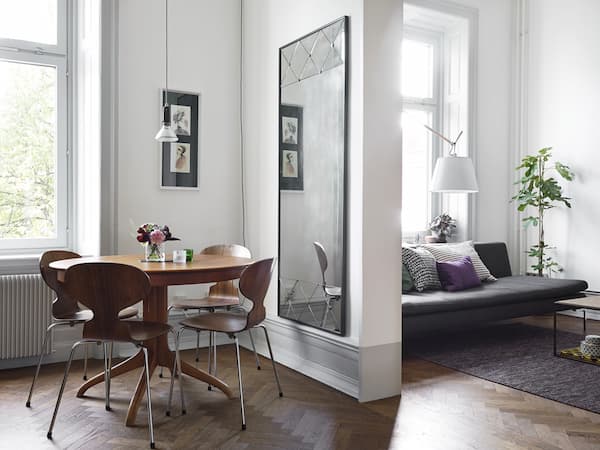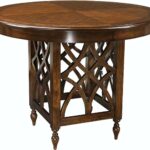While in the past people could only use a standard height table and chairs, now customers can choose according to their taste and space requirements. Dining tables and chairs are no longer just one height. You can choose the standard height, counter height, or bar height from many different collections of styles. This allows you to create a dining space that showcases your personality and satisfies your entertainment needs.
So what is the standard height of dining tables? The following guidelines can help you understand the standard height of dining tables for the most comfortable and elegant dining experience.
Table of Contents
What is Standard Height Dining?
The standard height of a dining room table is 28 to 30 inches (71 to 76 cm) and should be used with an 18 to 23-inch chair, stool or bench. Most restaurant tables fall within this range, but not always.
Some tables are shorter or taller to match the different types of furniture and styles. In short, however, you can expect most dining tables you buy to be within standard height.
Reasons to Choose a Standard Height Table
This traditional option is the most common and gives you the widest choice. You can mix and match chairs, stools, and benches in a variety of collections, styles, and finishes. Many people find average-height diners comfortable because their feet rest naturally on the floor, regardless of height. The standard height dining room is also very inclusive, as it is the ideal height for people in wheelchairs, and is more suitable for children, as the higher tables and chairs may require you to lift the child into the seat.
How Much Space Is Needed for a Dining Table and Chairs?
A dining table needs enough space to fit its exact size, plus 24 inches for each chair.
For example, a standard 72-inch (183cm) dining table can comfortably accommodate six people, with 24 inches of space per seat.
You can change the spacing to your liking, in part, by having some people sit at the front of the table. However, if you do, be sure to consider some extra length instead of width.
The dining table needs about 3 feet of breathing space in all directions to allow the seats to move in and out comfortably. This space should also not include any other furniture, so you must specify any kitchen utensils, sideboards, or other furniture that you plan to place near the dining table.
Tips for Picking Dining Room Heights
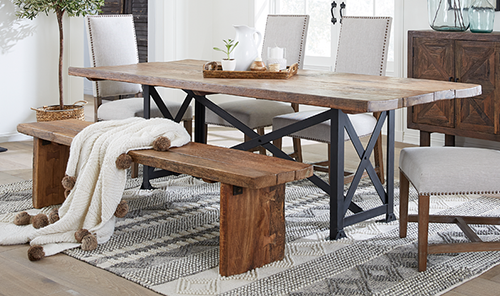
As mentioned above, what kind of restaurant you choose will largely depend on the space you have and your own personal style. Here are some tips to keep in mind.
Shape: The shape of the table should match the shape of the room. Shaped rectangular tables are traditional and are always a good choice if the room is the right size. A square table looks best in a smaller square room. Round tables work well in small rooms, giving a more intimate, comfortable feel. If the shape of the table does not fill the space properly, the proportions will deteriorate.
Measure the exact size of your room: That way you don’t waste time on tables and chairs that are too big or too small. In general, you want at least 24 inches between the table and the wall so that people can walk around. If people walk around the table a lot, you’d want about 38 inches.
The weight of the table: For example, if the table is thin, light, and spacious, the whole room will feel lighter. On the other hand, if it’s a thick, dark wooden table, it feels more grounded and heavy. In general, you want to keep a balance between the light and light parts of the room to keep it feeling spacious.
Style: It’s important to consider what works best for the size of your family. If you enjoy entertaining, remember what creates the best atmosphere for your guests. Style. In the end, it’s up to you. It should be! This is your home and you should choose a style, shape, and size that will make you comfortable for years to come.
Dining Table Width and Length
Dining table width and length are equally crucial considerations, in addition to table height. These two factors have an impact on the appearance of your space and the comfort of eating at your table.
Width
The table width – which is measured along the “head” of the table – impacts how easy it is to pass food and how many platters or serving pieces can fit along the center line of the table. To easily pass food across the table, the width should be no more than 48″. However, if you have a sideboard or buffet table and will only have place settings on the table, you can choose a narrower table that is as small as 30″ wide.
Length
For guests to eat comfortably (and avoid bumping elbows), each guest should have 24″ – 26″ of horizontal space. To steer clear of dings and scratches, keep 6″ between chairs. Knowing the length of the table will also help you determine how many chairs can fit at your table if you are purchasing chairs separately. Just keep in mind that the table’s legs may subtract a few inches from each side.
Dining Room Table Height Options
There are many different types of dining room tables to choose from, even though the standard height for kitchen tables is between 28 and 32 inches. Your preference for a taller dining room table may depend on your design aesthetic, the size of your room, and how frequently you use it. Fortunately, counter height and bar height tables provide a higher height without sacrificing any style.
Look at the three dining room table height options that are currently on the market and learn how to select the ideal height and style for your particular space.
Standard Dining Room Table Height
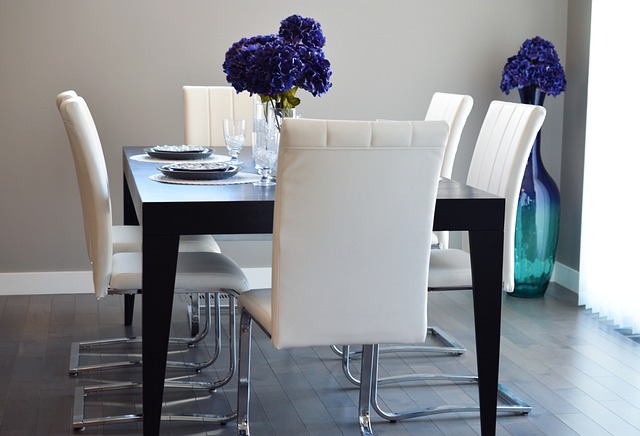
28 to 32 inches is the typical height for a dining room table. If you want to give a room a sophisticated, mature feel, this height is ideal because it tends to feel a little more formal. A standard height table can serve as a conversation piece for holiday meals in the dining room, for instance, if you have a formal dining room but usually eat dinner at the breakfast nook in your kitchen.
Not to mention, typical dining room tables frequently have leaves that allow them to be larger. If you frequently host a large number of guests or know that you’ll be covering your tabletop with heavy serving utensils, this feature is especially crucial. A table with one or two leaves can help you make better use of the space in your dining room, and the leaves are simple to tuck away when not in use.
Similar to this, families with a diverse range of ages and mobility can benefit from the universal height of standard dining room tables. Standard wheelchairs can even fit under tables that are easily accessible and of a standard height. In other words, for those seeking a dependable, formal dining option, standard dining room tables are best.
Counter Height Dining Tables
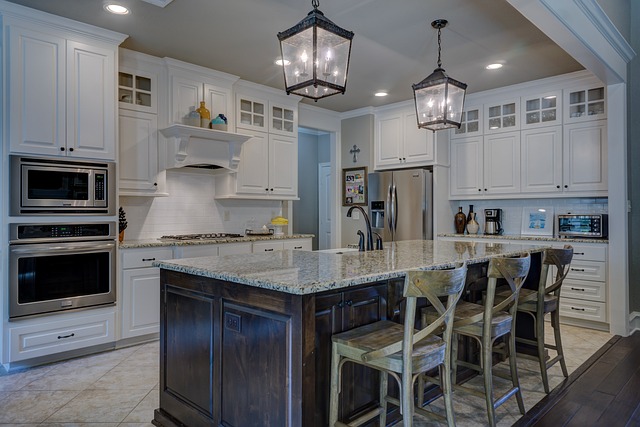
Consider counter height tables if you want a slightly taller dining room table height. Tables that are counter height range in height from 34 to 36 inches. Although those on the shorter side can be paired with regular dining chairs, they work best when paired with chairs or stools that measure 24 to 26 inches. Counter height tables give off a more relaxed vibe than standard height tables do.
Counter height tables offer guests the flexibility to gather by the table as a group rather than settle into a seat if you frequently host large gatherings that feature platters of food rather than formal sit-down dinners. Additionally, counter height tables look more open because of their height, making them perfect for small spaces. A counter height table might be the best option for you if your taste is more modern.
Bar Height Dining Tables

Bar height dining tables are the tallest type of kitchen tables, measuring 41 to 43 inches in height. They should be used in conjunction with high-top chairs or bar stools that are 28 to 33 inches high. Bar height tables can bring the ambiance of a classic pub right into your dining room, but due to their higher height, they work best in an informal setting.
Bar height tables can instantly create a sophisticated gathering space for family or friends when decorated with rich wood tones and deep hues. They can easily be transformed into a contemporary focal point if combined with bright whites and metallic accents. The one drawback of bar height tables is that you absolutely cannot use standard height chairs on them; as a result, you will need to buy a new set of bar stools.
FAQs
Standard Dining Chair Height
A uniform height for dining chairs? Most dining chair seats are roughly the same height (18 inches), but the height of the back of the chair greatly varies, and that’s the element that really sets the look of the dining room.
Standard Size of Dining Table for 4
Most rectangular tables are between 36″ and 40″ wide. A table that seats four should be about 48″ long. To seat four to six people, look for a table that is at least 60″ long. For six to eight guests, your table should be at least 78″ long.
Conclusion
To provide ergonomic and visually pleasing levels, your standard dining table should be between 28 and 30 inches (71 to 76 cm) tall and your dining chair between 17 and 19 inches (45 to 50 cm) tall.
This height is best for seats with feet on the floor and arms on the table and is proportional to the standard size of countertops and other furniture.

